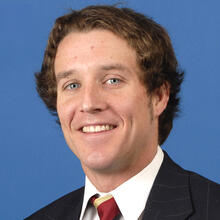- Home
- Private Health Coverage Declined, Became...
Private Health Coverage Declined, Became Less Secure in 2008
New Census Data Underscore Importance of Comprehensive Health Reform
The Census Bureau reported today that 46.3 million U.S. residents lacked health insurance in 2008, an increase of 632,000 over the previous year. [1] Nearly 6.6 million more people were uninsured in 2008 than in 2001, when the previous recession hit bottom. The proportion of the population without health insurance climbed to 15.4 percent in 2008, slightly above (but not statistically different from) the 15.3 percent rate in 2007 and considerably above the 14.1 percent figure in 2001.
The number and share of people without health insurance are doubtless higher now (in September 2009) than these figures show, since the unemployment rate has grown substantially over the past year and many people have lost their health insurance along with their job.
In addition to a continued deterioration in overall health insurance coverage, the new Census data show that health coverage has become less secure across many sectors of the population, including groups that have typically been more likely to have coverage (such as full-time workers, non-Hispanic whites, and middle-income families).
- The percentage of Americans without health insurance has increased since 2001 largely because employer-sponsored coverage, the principal source of coverage for the non-elderly, has eroded. (See Figure 1.) In 2008, 61.9 percent of the non-elderly had health coverage through an employer, down from 62.9 percent in 2007 and 67.0 percent in 2001.
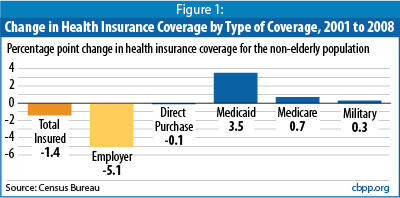
- The number of children without insurance fell by 801,000 in 2008, due to an expansion in government health insurance programs for children. But the number of workers without coverage rose by 932,000 — evidence of the continued erosion of employment-based coverage.
- Holding a job does not guarantee health coverage, and the percentage of full-time workers who are uninsured has climbed. (See Figure 2.) The percentage of full-time working adults age 18-64 who lack health insurance rose to 17.2 percent in 2008, up from 17.0 percent in 2007 and 15.5 percent in 2001. The percentage of part-time working adults who lack health insurance rose to 25.4 percent in 2008, up from 23.4 percent in 2007 and 20.9 percent in 2001. Among those not working, the percentage without insurance reached 26.0 percent in 2008, up from 25.4 percent in 2007 and 23.8 percent in 2001.
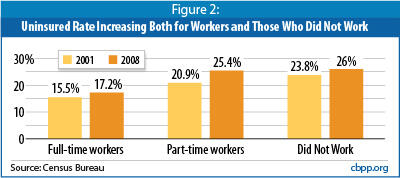
- Although minorities remain much more likely to be uninsured, the percentage of people without insurance is increasing fastest among non-Hispanic whites. (See Figure 3.) Since 2001, the proportion of non-Hispanic whites without health insurance has grown from 9.4 percent to 10.8 percent in 2008. Almost one-fifth of African-Americans and one-third of Hispanics had no health insurance last year.
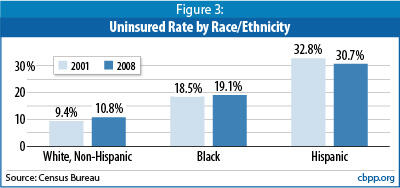
- Low-income people continue to be the least likely to have insurance. Some 24.5 percent of people with incomes below $25,000 were uninsured in 2008, roughly triple the rate among people with incomes of $75,000 or more, which stood at 8.2 percent.
- The lack of insurance is expanding most rapidly among moderate- and middle-income individuals. (See Figure 4.) The share of people with income between $25,000 and $49,999 who are uninsured rose from 17.3 percent in 2001 to 21.4 percent in 2008. Similarly, among those with income between $50,000 and $74,999, the percentage without health insurance has increased from 10.8 percent in 2001 to 14.0 percent in 2008.
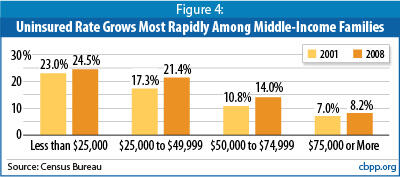
The Census Data and the Debate over Health Reform
These Census data demonstrate a growing lack of health insurance across a large swath of the population. They speak to the mounting need for comprehensive health reform that achieves near-universal coverage and aims to slow the rate of growth in health care costs, as various proposals before Congress seek to do.
For example, to stem the continuing erosion in employer-based coverage, the health reform bill that several House committees have approved would provide small businesses with new subsidies and options to offer health insurance, ensure that most employers either offer coverage or contribute to the cost of their workers’ health insurance, and encourage more workers to participate in their employer’s plans by requiring individuals to have health insurance. According to the Congressional Budget Office, the House bill would result in several million more people enrolled in employer-based coverage than under current law.
Most significantly, to address the increasing number of workers without access to employer-based coverage, the House bill, the bill approved by the Senate Health, Education, Labor, and Pensions (HELP) Committee, and the plan being developed in the Senate Finance Committee would all establish a new health insurance “exchange” or “gateway.” Insurers would be required to offer a variety of plans with comprehensive benefits, without charging higher premiums based on people’s health status or denying coverage to older or sicker individuals.
To help moderate- and lower-middle-income people (with incomes too high to qualify for Medicaid) afford such coverage, these bills would provide premium subsidies for plans purchased through the exchange or gateway as well as subsidies to help defray deductibles and cost-sharing charges. To provide health coverage to low-income individuals and families, both the House bill and the Senate Finance plan as it currently stands would expand Medicaid to all non-elderly adults below 133 percent of the poverty line.
President Obama endorsed these same provisions as key elements of comprehensive health reform legislation in his speech to Congress on September 9.
Without changes in policy, the Congressional Budget Office expects that the number of uninsured will continue to rise and reach 54 million by 2019. In contrast, the House health reform bill would reverse the sizable increase in the number of uninsured people that has occurred since 2001 and sharply lower the number of uninsured. CBO estimates that the House bill would reduce the number of Americans without health insurance by 37 million by 2019, compared to current law — from 54 million to 17 million.[2] Moreover, the percentage of U.S. citizens and legal immigrants who are uninsured would fall to 3 percent by 2019.
Conclusion
The new Census data show that the number and percentage of U.S. residents without health coverage have increased substantially since 2001. The data demonstrate that health insurance coverage is becoming increasingly insecure even among parts of the population that are more likely to have coverage. Without action, these figures are expected to worsen over the coming decade.
Congress and the President have a historic opportunity to reverse these damaging trends by enacting comprehensive health reform that both achieves near-universal coverage and takes steps to slow the rate of growth in health care costs.
End Notes
[1] U.S. Census Bureau, Income, Poverty, and Health Insurance Coverage in the United States: 2008, Series P-60, September 10, 2009.
[2] Congressional Budget Office, “Preliminary Analysis of the Insurance Coverage Specifications Provided by the House Tri-Committee Group,” July 14, 2009. These estimates were completed prior to markup and modification of the bill by the House Ways and Means Committee, the House Energy and Commerce Committee and the House Education and Labor Committee, but the coverage estimates are likely to be very similar.
More from the Authors
